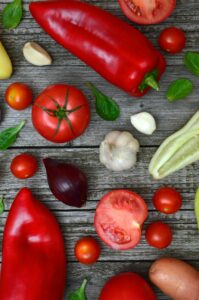High blood pressure, also known as hypertension, is often called the “silent killer” because it can quietly damage your body for years before symptoms become apparent. It is a major risk factor for heart disease, stroke, and kidney failure. The good news is that high blood pressure is manageable, and in many cases, preventable through lifestyle changes. From a clinical nutritionist’s perspective, the focus is on using food as a tool to control and lower blood pressure effectively.
Understanding Blood Pressure
Blood pressure is the force exerted by the blood against the walls of the arteries. It is measured in two numbers:
- Systolic pressure: The top number, indicating the pressure when the heart beats.
- Diastolic pressure: The bottom number, representing the pressure when the heart is at rest between beats.
A normal blood pressure reading is typically around 120/80 mm Hg. Blood pressure is considered high when the reading consistently exceeds 130/80 mm Hg.

Nutrition’s Role in Managing High Blood Pressure
1. Embracing the DASH Diet
One of the most effective dietary strategies for managing high blood pressure is the DASH (Dietary Approaches to Stop Hypertension) diet. The DASH diet emphasises whole foods, rich in nutrients like potassium, calcium, and magnesium, which are essential for blood pressure regulation.
Key components of the DASH diet include:
- Fruits and Vegetables: These are high in potassium, a mineral that helps balance sodium levels in the body, reducing its impact on blood pressure.
- Whole Grains: Foods like oats, brown rice, and whole-wheat bread provide fiber, which can help lower blood pressure.
- Lean Proteins: Opt for poultry, fish, and legumes over red meat. Fish, in particular, contains omega-3 fatty acids that are beneficial for heart health.
- Low-Fat Dairy: Milk, yogurt, and cheese are rich in calcium, which supports healthy blood pressure levels.
- Nuts and Seeds: These are good sources of magnesium, another mineral that helps regulate blood pressure.
2. Reducing Sodium Intake
Excessive sodium is one of the leading contributors to high blood pressure. Sodium causes the body to retain water, which increases blood volume and, consequently, blood pressure. Most people consume much more sodium than they need, often through processed foods, restaurant meals, and even certain condiments.
To manage blood pressure:
- Limit processed foods: Choose fresh or minimally processed foods whenever possible.
- Read labels: Look for low-sodium versions of your favorite products, and be mindful of the sodium content in packaged foods.
- Season with herbs and spices: Instead of salt, use herbs, spices, lemon juice, or vinegar to add flavor to your meals.
3. Increasing Potassium Intake
Potassium helps counteract the effects of sodium in the body, relaxing blood vessel walls and aiding in the excretion of sodium through urine. Foods rich in potassium include bananas, sweet potatoes, spinach, avocados, and beans.
A potassium-rich diet can significantly help lower blood pressure, but it’s important to balance potassium intake, especially if you have kidney issues. Consulting a nutritionist can help tailor your diet to your specific health needs.
4. Managing Weight Through a Balanced Diet
Excess weight, especially around the abdomen, can raise blood pressure. Losing even a small amount of weight can have a significant impact on blood pressure levels.
Focus on a balanced diet that includes:
- Portion control: Eating smaller portions can help with weight management.
- High-fiber foods: Foods high in fiber, such as fruits, vegetables, and whole grains, can keep you full longer, reducing the likelihood of overeating.
- Healthy fats: Include sources of unsaturated fats like olive oil, nuts, and fatty fish, while limiting saturated and trans fats.
5. Limiting Alcohol and Caffeine
Alcohol and caffeine can raise blood pressure, especially if consumed in excess. While moderate alcohol consumption may have some health benefits, it’s important to drink in moderation. For most adults, this means up to one drink per day for women and two for men.
Caffeine’s impact on blood pressure varies from person to person. If you’re sensitive to caffeine, it’s wise to monitor your intake, limiting it to no more than 300-400 mg per day (about 2-4 cups of coffee).
6. Increasing Calcium and Magnesium Intake
Calcium and magnesium play key roles in blood pressure regulation. Low levels of these minerals are associated with higher blood pressure.
Include these in your diet:
- Calcium: Dairy products, leafy greens, and fortified plant-based milks.
- Magnesium: Whole grains, nuts, seeds, legumes, and green leafy vegetables.
Lifestyle Changes to Complement Nutrition
Diet alone can make a significant difference, but lifestyle habits also play a crucial role in managing blood pressure.
1. Regular Physical Activity
Exercise is a powerful tool for lowering blood pressure. Aim for at least 150 minutes of moderate-intensity aerobic activity, such as brisk walking or swimming, each week. Strength training exercises also contribute to overall heart health.
2. Managing Stress
Chronic stress can contribute to high blood pressure. Techniques such as deep breathing, meditation, yoga, and other relaxation exercises can help manage stress and, in turn, support healthy blood pressure levels.
3. Quitting Smoking
Smoking damages blood vessels, leading to an increase in blood pressure. Quitting smoking is one of the most effective ways to improve heart health and lower blood pressure.
Personalised Nutrition Plans
High blood pressure management isn’t a one-size-fits-all solution. As a clinical nutritionist, I work with clients to develop personalised nutrition plans that take into account their specific health conditions, lifestyle, and preferences. Regular monitoring and adjustments ensure that the plan remains effective over time.
Conclusion
Managing high blood pressure is crucial for preventing serious health complications. By adopting a balanced diet rich in fruits, vegetables, whole grains, and lean proteins, while reducing sodium and alcohol intake, individuals can significantly improve their blood pressure levels. Coupled with regular exercise and stress management, these dietary changes can lead to lasting improvements in overall health. For tailored advice and support, consulting with a clinical nutritionist can provide the guidance needed to successfully manage high blood pressure.
4o







